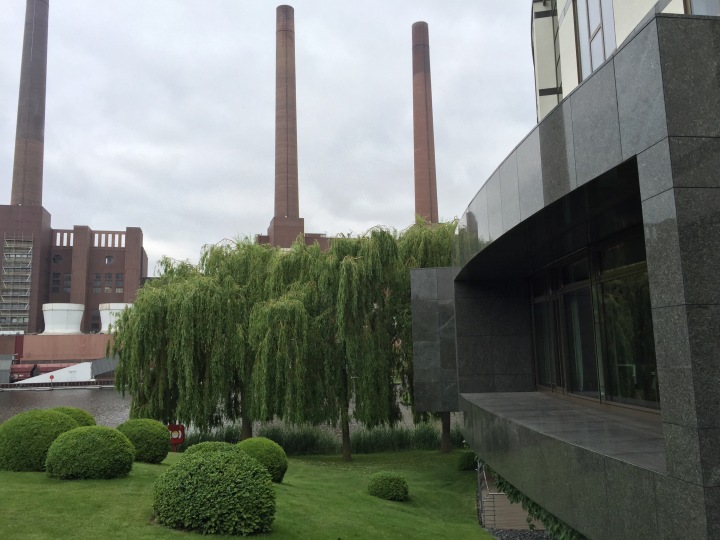
Restaurant Aqua of chef Sven Elverfeld is the 3 Michelin star restaurant located in the Ritz-Carlton in Autostadt, the Volkswagen theme park in Wolfsburg, in the middle of Germany near Hannover. It is listed as #33 on the World’s 50 best restaurants, and as it is ‘only’ a 4-hour drive due east from Amsterdam, it was about time we paid a visit. And so I chose this as the location to celebrate our wedding anniversary (as a surprise for Kees).
We opted for the 9-course “Impressions” menu (230 euro) with the “premium wine journey” (175 euro for 9 glasses). It is offered as an attractively priced package deal “Delightful Discovery” that includes champagne, coffee, as well as bed and breakfast at the Ritz-Carlton (all inclusive for 995 euros for two). There are several other degustation options available, starting at 4 courses for 160 euros with the premium wine journey for 95 euros.
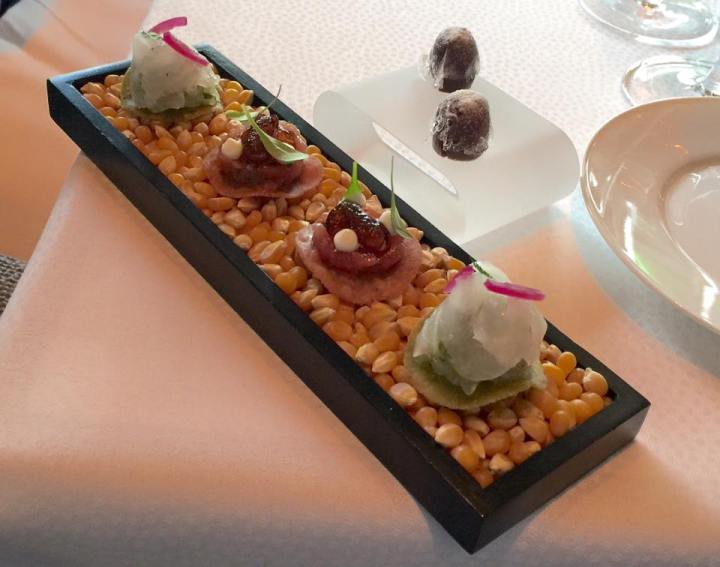
The “snacks” start out with kalamata olive with crispy sugar and two types of tacos: chili con carne and sea bass ceviche with cactus. A nice touch that it is served on corn. Very nice textures and flavors to start with.
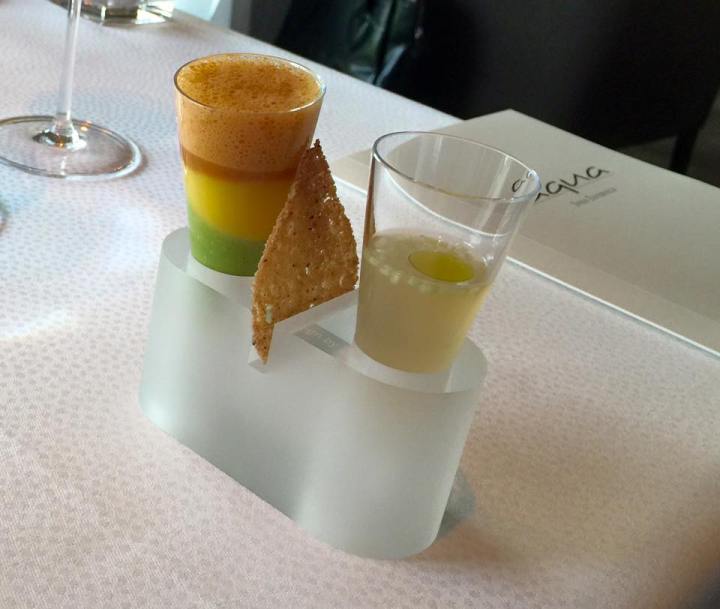
The “soup shots” with a buckwheat crisp. The fruit-verbena soup was nice, but the three layers of bell peppers was simply amazing. For starters, the texture of each layer is different such that you first drink the red pepper, then the yellow, and then the green, so they don’t mix and you get to taste each one individually. The flavor of the red and yellow bell pepper soup was simply astounding. It tastes like bell pepper (roasted bell pepper in case of the red one), but somehow ‘better’.
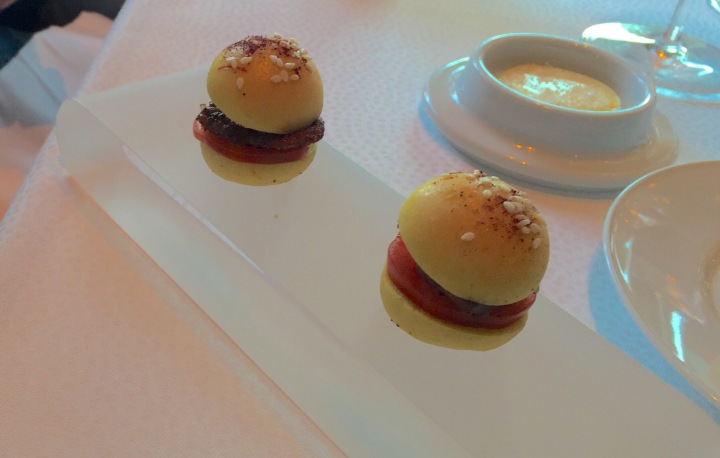
The mini-hamburgers with lamb, yogurt, dates, mint, and hummus, were nice, too.
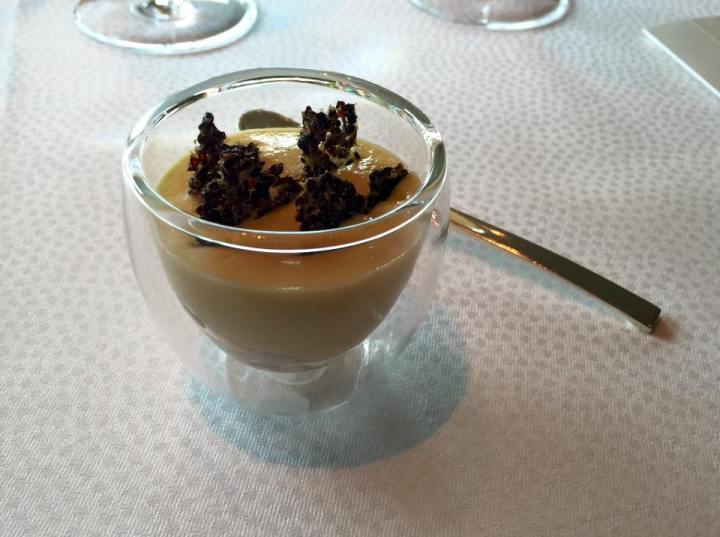
The final “snack”: sashimi of hamachi (yellowtail) with guacamole, smoked corn foam and black quinoa crisps. This play with textures, temperatures, and flavors is typical of the chef. Sometimes a menu takes a completely different course after the amuse bouche, but in this case they were a very good indication of what was to follow. Just the bell pepper soup alone makes this set of amuse bouche worth 10/10!
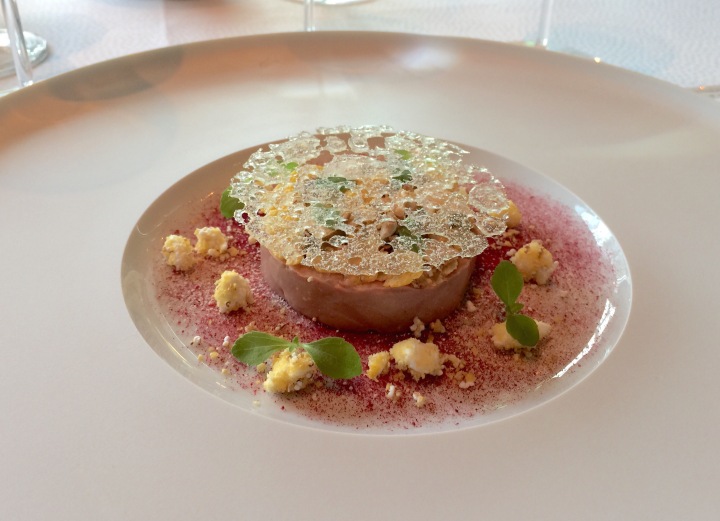
On of the prettiest looking dishes of the evening was this Foie Gras „Muesli“ with cottage cheese, yogurt, cereal, fruits and almonds. The combination of foie gras with sweets is always a winner, and in this case there were also a lot of different textures. This came with a Riesling Auslese from Nahe, a late-harvest riesling with an excellent balance between sweetness, creaminess and freshness that worked very well with the dish. In many cases the residual sugar and the acidity of Auslese Rieslings are not well-integrated, but in this case it was perfect. 9/10

Tuna, lackered and warmed gently, with grilled slices of white and green asparagus, and icecream of orange and ginger, with tarragon. Again a wonderful play of temperatures, textures, and flavors. Paired well with a Grüner Veltliner from Wachau. 9/10

Trout with its caviar, lettuce, mushrooms, and hazelnut. The trout was perfectly cooked (probably sous-vide) and provided mostly a creamy textural element in contrast with the crispy lettuce. The mushrooms were present as a flavorful stock as well as raw mushrooms, and the hazelnuts worked very well with this. The sommelier surprised us with a 2003 Chablis Grand Cru from William Fèvre that was perfectly matured and worked very well with the dish as it brought out the flavors in the wine. 9/10

Snails with Frankfurter herbs, potato stock, marrow-emulsion, duxelles and caviar of snails. The “Frankfurter” herbs had a strong flavor that went nicely with the snails, like the traditional combination of snails with parsley and garlic. The pairing with a Sauvignon Blanc from Valle de Uco, Argentina, worked well. This was our least favorite dish, but it was good all the same. 8/10

Gillardeau oyster, poached as well as raw marinated, with veal head ragout, caviar, fennel, dill, celery and samphire. The combination of components works very well and again there is a great play between textures, temperatures, and flavors. Sommelier Marcel Runge explained to us that he had a hard time finding a wine that would match both the oyster and veal head ragout, but he succeeded marvelously with a 1994 white Rioja. The producer ages it for a long time in oak casks and then in the bottle before releasing the wine — 1994 is the vintage that is currently released! The wine seems a bit simple at first, but the dish really brings out the flavor of the wine. 10/10
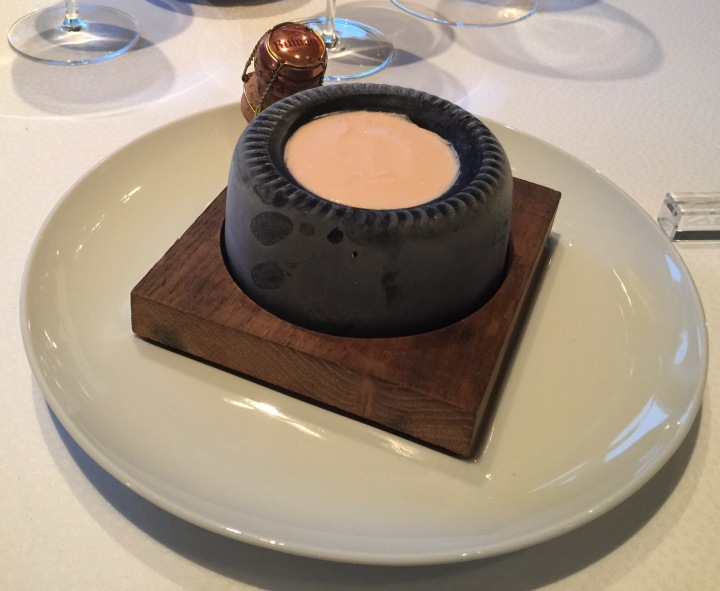
The cream sorbet of Ruinart rosé champagne is served on the bottom of an actual bottle of the same champagne. The flavor of the rosé champagne comes out very well, well done.

Loin of roe deer venison “Waldorf” style with celeriac, apple, walnuts, and peas. The roe deer is perfectly cooked (sous-vide?) and it works with the “Waldorf” components, but as in many cases the “main” course was not our favorite. A syrah from Canada sounds to good to be true, and it was, as the wine had green tannins that were not softened enough by age (it was a wine from 2009) or pairing with the roe deer. When I commented about this to the sommelier, he immediately replaced with an elegant syrah from South Africa that worked very well with the dish. 8/10

Then the maitre Jimmy Ledemazel came with a trolley full of perfectly matured raw-milk cheeses and asked what we would like. Well, we like cheeses that work with the wine. So this usually means picking a wine and then selecting cheeses to go along with that. He conferred with the sommelier, and presented us with 4 different cheeses each so we could share. It was a mixed selection of washed rind, goat, and blue cheeses, so we were very curious (and perhaps just a bit skeptical) about what wine would work with all of those. Well, we should not have been skeptical because the 2004 Pinot Gris from Alsace that was selected by the sommelier worked wonderfully with all of the cheeses. The wine had aged wonderfully and had just a touch of residual sugar that worked very well with the cheeses. Each cheese brought out something else in the wine. All in all a rare combination of cheeses that work with the wine, are perfectly matured, and served at the right temperature. 10/10 without a doubt.

On to the first dessert: rhubarb with wheat grass and yeast ice cream. Another original combination of flavors and textures, paired well with a Beerenauslese from Burgenland, Austria. 9/10

The second dessert: pickled carrots with mango and “Manjari” chocolate. The pickling had transformed the carrots such that you could hardly recognize them as such. It worked very well with the chocolate, and the wine pairing with a Passito di Pantelleria was outstanding. 9/10

Greek yogurt with raspberries and strawberries with something that seemed to be fettuccine.
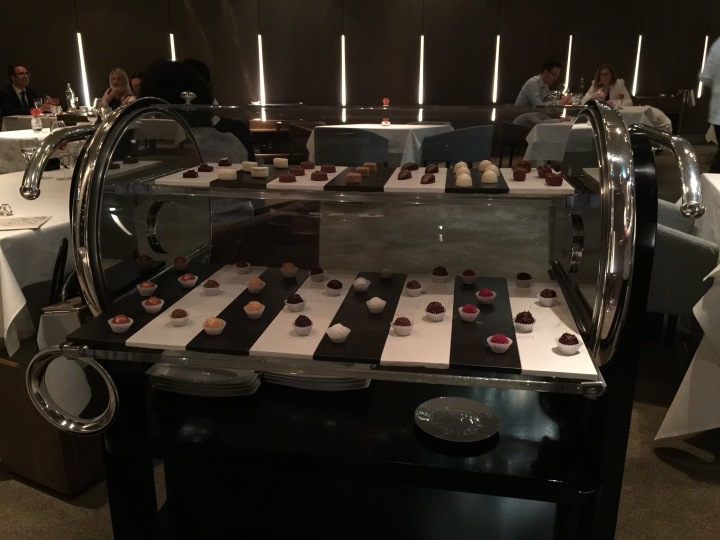
To finish with the coffee or tea, a wonderful selection of delicious pralines with exotic flavors.
My verdict
This was our first time at Aqua. Chef Sven Elverfeld has a clear style in his food: he plays with flavors, textures, and temperatures. It is creative without extremes. Everything ‘works’ and the technical execution is perfect. The level of the dishes is very constant at a solid level truly worthy of three Michelin stars. 9.5/10 for the food.
The service is good with personal attention like a personalized menu and not overly formal. There was only one glitch as initially there was no wine served with the second dessert. But luckily it wasn’t the kind of dessert that melts, and after only a couple of minutes it was fixed. 8.5/10 for the service.
Now what is most special about Aqua is the wine pairings. When awarding Michelin stars, the largest weight is clearly given to the food. But to me, the wine is as important as the food. And so at many 3-star restaurants with a similar level of food as Aqua we are disappointed because no wine pairings are offered at all (like at Berasategui) or the wine pairings don’t work (like at Reale). Or the wine pairings work, but the quality of the wines is not comparable to the food because of a budget restriction. This means that you can’t drink three-star wines with the three-star food. In such restaurants the wine pairing costs half or less of what the food costs. I would gladly pay more for premium wines, but such an option is not often offered.
The wine journey at Aqua is truly a premium one. Sommelier Marcel Runge does a great job of selecting the wines and actually tasting a selection of wines with each dish before choosing which wine works best. This may sound like the logical thing to do, but unfortunately many sommeliers pick wines ‘in theory’ without ever tasting them with the dish (like at Samhoud).
And yes, the wine pairing at Aqua is more expensive at 175 euros for 9 glasses than at other restaurants, but it is absolutely worth it. If you are willing to pay 230 euros for 9 courses of food and you like wine, you should also be willing to pay 175 euros for the wine. So I applaud Sven Elverfeld and Marcel Runge for making this choice. At Aqua, all the wines are high quality, and aged properly, and without exception all work very well with the food. So for the very first time on this blog, I’m awarding 10/10 for the wine pairings. Well done! We keep hoping that other three-star restaurants will follow the example and start offering three-star wine pairings with their three-star food.
It goes without saying that we will come back for more.


Happy Anniversary. 🙂 Looks like you and Kees had a wonderful meal. I agree with you on the wine – if you’re willing to pay good money for a great meal and you like wine, don’t skimp on the price. Just do it. 🙂
LikeLiked by 1 person
Deve essere stata un’esperienza veramente incredibile, una serata indimenticabile con un menù notevole: perfetto per un anniversario! Auguri e felicitazioni!
LikeLiked by 1 person
That looks wonderful Stefan. Happy anniversary to you both.
LikeLiked by 1 person
Happy Anniversary after the event! Were you there perchance to pick up a new vehicle as well 🙂 ? Am laughing at your ‘4-hour drive’ being long: I know many people here who daily drive 3 hours or more each way to work!! Now the restaurant – have to go back and retaste but it has a ‘different feel’ to me from many other of your degustation menus. Like it immensely tho’ it must have been a 4-hour meal! First courses quite remarkable and both snails and oyster attract! Thanks!!
LikeLiked by 1 person
Thanks Eha. We are not car people, so we completely ignored the Autostadt. The meal lasted more than 4 hours, so at least it took longer than the drive to get there (not counting the return drive though). We like long dinners like that. A 4-hour drive in the Netherlands and Germany is quite a bit more stressful than a similar drive in rural Australia, but perhaps quite comparable to a more metropolitan area like Sydney.
LikeLike
Nice one Stefan. I agree with you on the wines. It’d be a disaster not to have the best wine with the best food. As you say it’s not hard to do.
LikeLiked by 1 person
Not hard to do, but surprisingly hard to find a restaurant that does it as well as Aqua.
LikeLike
Surprised to hear that you did not visit de Librije this year for your anniversary (congratz btw :-)). Was curious to hear your opinion on the “new” Librije as I ate their last February… Anyways, Aqua seems like a great option as well!
LikeLike
Hi Vincent, we celebrate two anniversaries each year, our wedding in June and our first date in December. This year we decided to go to Librije in December (we already have reservations) and go somewhere else in June. Aqua definitely is a great option. Did you like the ‘new’ Librije? I do not expect the food to be very different, just the location?
LikeLike
Once again, Happy Anniversary! Vicarious dining at its finest!
LikeLiked by 1 person
Naomi loves the photos and says they are beautiful! 🙂 Obviously the shot of the cheese followed by the yellowtail pics are my favorite. 😉 The juicy lamb slider sounds nice with the sweet dates! Happy anniversary!
LikeLiked by 1 person
Thank you Shanna, it was very nice. I like about Aqua that although the food did look nice, it was clear that most of the effort went into the flavor rather than the presentation.
LikeLiked by 1 person
Flavor, texture and overall taste over all else every time!😊😊😊
LikeLiked by 1 person
Happy anniversary to the both of you! I cannot think of a single restaurant around here within a 3 or 4 hour drive of Bend that is a 3-star restaurant with a degustation menu. Maybe Portland, OR has one? I’ll have to investigate… Nonetheless, it all looks fantanstic! Congrats!
LikeLiked by 1 person
Thanks. It is good to remember how blessed we are that we have several three star restaurants within a 4 hour drive, as well as some really good 2 star restaurants.
LikeLiked by 1 person
Great culinary journey! I’m a little disappointed the Canadian Syrah didn’t hold up! I live about 3 hours from our country’s major wine region and have had some excellent experiences. I should provide some recommendations for you so that you are not entirely turned off!
LikeLike
From what I know about Canadian wine (which is very little), the vintage makes a big difference. In good vintages the wines can be outstanding with great elegance, but in colder vintages the grapes don’t ripen sufficiently and some harsh green tannins remain that won’t soften much with age. I am especially sensitive to such green tannins, so others may enjoy this more.
LikeLike